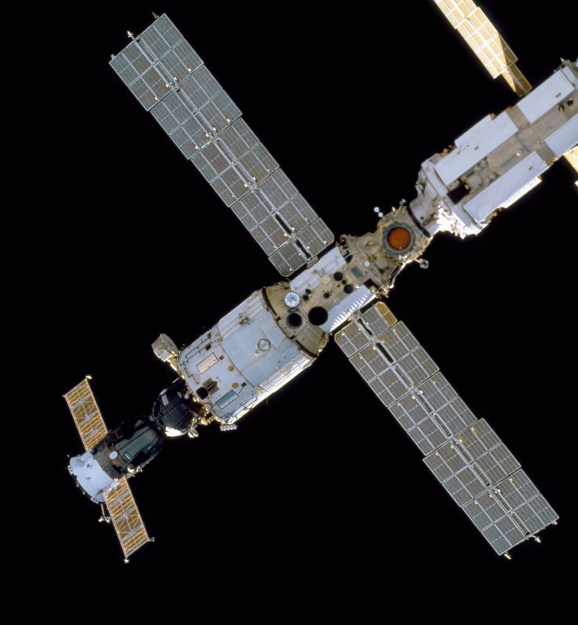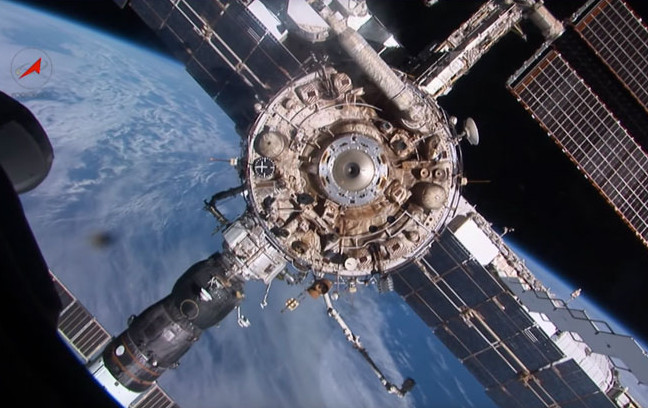Anyone who’s ever owned an older car will know the feeling: the nagging worry at the back of your mind that today might be the day that something important actually stops working. Oh, it’s not the little problems that bother you: the rips in the seats, the buzz out of the rear speakers, and that slow oil leak that might have annoyed you at first, but eventually just blend into the background. So long as the car starts and can get you from point A to B, you can accept the sub-optimal performance that inevitably comes with age. Someday the day will come when you can no longer ignore the mounting issues and you’ll have to get a new vehicle, but today isn’t that day.
Looking at developments over the last few years one could argue that the International Space Station, while quite a bit more advanced and costly than the old beater parked in your driveway, is entering a similar phase of its lifecycle. The first modules of the sprawling orbital complex were launched all the way back in 1998, and had a design lifetime of just 15 years. But with no major failures and the Station’s overall condition remaining stable, both NASA and Russia’s Roscosmos space agency have agreed to several mission extensions. The current agreement will see crews living and working aboard the Station until 2030, but as recently as January, NASA and Roscosmos officials were quoted as saying a further extension isn’t out of the question.
Still, there’s no debating that the ISS isn’t in the same shape it was when construction was formally completed in 2011. A perfect case in point: the fact that the rate of air leaking out of the Russian side of the complex has recently doubled is being treated as little more than a minor annoyance, as mission planners know what the problem is and how to minimize the impact is has on Station operations.
Reading Tea Leaves, Literally
While the leak might have been generating some additional buzz over the last week or two, this is only the latest chapter in a story that’s been unfolding for several years.

You can find similar headlines popping up every year or so since at least 2019, and even back that far, it was noted that the Station was constantly losing breathable atmosphere to some degree. It’s only considered a proper “leak” when ground controllers see a notable spike in the normal amount of air being lost.
By 2020, the rate of air being lost was getting to the point that NASA and Roscosmos decided it was worth spending some time to investigate. So during a (relatively) slow operational period, with only three crew members aboard, all of the inter-module hatches were closed throughout the Station. The air pressure in each module was then carefully monitored over the next several days, an effort which ultimately determined the leak was somewhere within the Russian Zvezda module.
Once it was determined the leak was on the Russian side of the complex, cosmonauts started a more localized search. By 2021, they were watching thin strips of paper and tea leaves as they were carried by air currents within Zvezda. This allowed them to identify a few cracks in the hull where air was escaping, which were taped up to help slow the bleed.
An Intermittent Problem
Our latest update comes from NASA’s International Space Station Program Manager, Joel Montalbano. In a February 28th media briefing ahead of the launch of the SpaceX Crew-8 mission, Montalbano explained that the Station leak rate doubled to approximately 0.9 kilograms air per day as preparations were made to dock the Progress MS-26 cargo spacecraft to the Station.

It was eventually determined that the leak was within the one-meter long vestibule in the rear of Zvezda known as the PrK, which acts as a sort of air lock between a visiting Progress spacecraft and the rest of the module. The leak rate only increased when the inner hatch to this chamber was open, and went back to normal as soon as it was closed. Since this hatch only needs to be open during active loading and unloading of a Progress vehicle, NASA feels confident that it presents no risk to the crew or the Station.
Even still, Montalbano did say the situation was being continuously monitored from the ground, and that Russian engineers are currently looking into locating the leak within the PrK and patching it permanently. It was also explained that, thanks to the nature of the PrK chamber, even if the leak were to become worse and found to be beyond repair, it would pose no risk to the Zvezda module. It could potentially mean permanently losing access to the docking port on the other side of the PrK however — an unfortunate, but not insurmountable, situation.

















At 80000 US dollars per kilogram, I’d hope they’d be a little more concerned about air loss:
https://space.stackexchange.com/questions/65534/how-much-does-air-on-the-iss-cost
If nothing else, every kilogram of air they have to replace is a kilogram less of other materials that could have gone to space.
Then there’s the whole “minor leak becomes major leak” leaving you with no air at all.
So, about 40 000 usd/day in operational costs just for air loss, based on the price you stated and half of the doubled-to-0.9kg/day loss. idk how that compares to the rest of the operational costs. (Nor what it would cost to find and fix the leak. Would be nice if some kind of harmless-but-expands-in-vacuum powder existed…)
> The International Space Station costs about $3 billion per year for NASA to operate
So, some quick math says it’s ~.5% of the operating costs. Not great, but not a huge amount.
That’s very close to the lifetime (many years) mission cost of a Perseverance class nuclear powered Mars Science Laboratory and I’ll bet that $3 billion figure is lowball. Deorbit that white elephant in search of a mission that is even remotely worth its support cost alone. Book: The End of Astronauts: How Robots are the Future of Exploration (2022)
Given that it’s a massively successful experimentation platform that is actually in operation, yes it’s worth it. Purely robotic missions are also expensive and often can’t be salvaged when a minor problem causes them to fail, we see this every few months. Among all the space projects so far it is among the most successful, especially due to modularity and being the sole platform to test humans in space.
no bucks, no buck rodgers.
Put it in a balloon of nitrogen/argon at the same pressure as the interior. No leaks. Build a hard shell around it and you are on the way to a real space-station.
Would the shell be constructed in-situ or launched? I don’t know if we have a vacuum-compatible sprayable material capable of doing structural work on orbit. A shell could be manufactured on Earth and launched to the station at whatever rate makes the most economic sense, but even just screwing stuff together in vacuum is an expensive pain in the ass.
That said, I now want a story where such a dome is needed and the contract is handed off to JAXA (Japan’s space agency), who subcontracts to De Agostini models. De Agostini publishes occasional magazine model subscriptions in Japan. You get sections of the model every month until the kit is complete. The reason I picked them is that they did this with a working 3D printer back in 2014. I could totally see JAXA using random nooks on launch vehicles to send up the pieces of a hab module one piece at a time.
And what material do you use for this balloon?
Aluminized mylar seems to work remarkably well. Heck, you can sputter-coat the outside with gold or something else UV-hardened and have it work for quite a while.
I wouldnt be suprised if aluminized mylar is the “tape” mentioned.
For sputter coating, probalbly not the most efficient idea, it would take an eternity to create a coating sufficently thick to have any structural integrity.
I would be surprised if it *wasn’t* the mentioned tape, perhaps even an aluminium backed high duty cycle variant. As for sputtering…. Definitely not something to do inside even if it could be done with available equipment.
I love when internet commenters solve a problem for teams of literal rocket scientists in one sentence.
I bet NASA will feel pretty stupid when they read this.
Verily.
https://youtu.be/_7NiBD3KqkQ
I think people here just like to brainstorm and have a conversation about problems like this. Most of use dont really think we know much more than those actually in the position to solve the problems. Some are also curious “why cant you do x?”
That said having a large group of people brainstorm something often does generate some really innovative ideas that escape soemone who is too close to the problem.
“rocket scientist” became used that way back when such knowledge was obscure, unknown, and highly specialized, similar to how “brain surgeon” is used. Firstly, rocket science is much better understood now, and secondly… This isn’t rocket science. Odds are, a specialized rocket scientist will have little input into this question, being outside their field of study.
That is what interested enthusiasts do, about everything, and it’s not a bad thing as it’s driven by curiosity and often enough actual knowledge. Sure, people may miss things because they aren’t actual ISS engineers or we’re missing some important information, but many of the people here *are* engineers, and occasionally rocket scientists too.
Why not spray the leaky inside with tire sealant? Or a similar stuff. It should collect wjere the leak is and seal it.
I imagine you dont want to release a whole bunch of toxic and flammible VOCs in a place where you cant just open a window.
Your balloon will leak after first micrometeoroid comes by.
And after the first microimpact event…what?
Stuf in space gets smacked with high speed dust ALL THE TIME.
A thin, gas tight envelope doesn’t stay gas tight for long.
I’d be worried about the cracks propagating catastrophically. After all the ISS is a pressure vessel.
Quite so …. this is what tends to happen with cracks and pressure vessels. I’ll be sending my ticket to the ISSS back for a refund.
I imagine that, as the people who design, build, and operate such things, they’ve assessed that risk and determined it to be of no concern.
That is more or less what we’re looking at, and basically the subject of the article. The Zvesda module is in bad shape and needs real repairs. The damage is unlikely to affect the rest of the station…. But it’s being used for deliveries so it’s a problem.
“This allowed them to identify a few cracks in the hull where air was escaping, which were taped up to help slow the bleed.”
*insert commercial for duct tape*
I am honestly shocked that Phil Swift (CEO of Flex Tape, and the “That’s a lotta damage” meme incarnate.) isn’t in Baikonur at this very moment preparing for the PR stunt of the century. In his place I would at least find out if I’m able to handle the trip.
“NASA feels confident…”
https://www.popsci.com/article/technology/gallery-top-10-failed-nasa-missions/
Maybe the crew should keep a gallon of ‘Flex Seal’ on hand … just in case… I was watching on TV in 1986 when the Challenger’s solid rocket booster blew an O-ring.
IMO: NASA has lost control of their vision and budget. Like Homeland, NASA is too big to be effective.
The future of space is embodied in private companies such as SpaceX, Orbital, Sierra Space, etc.
Fact is, NASA is simply no longer necessary now that the military has Space Force and the civilian environment is beginning to be well covered. Private companies can just do it better than a top-heavy Federal-directed entity trying please the fools in Congress while throwing around billion$ for technically incompetent projects.
Space is simply too important to allow an entity like NASA to control the direction science is pointed.
The private companies are on contract to NASA, and until such time as a private launch firm is financing continuous ops out of its own pocket, NASA is still necessary.
Even if a private company or two is financing its own launches continuously NASA or something like it would be wanted – there is a reason standards groups exist and to some extent NASA may become the standards group for commercial space operations. It is also likely continue to take on operations that have no prospect of bumping the stock price in the next few months, but will prove valuable eventually…
But we all pay for it, regardless of what actually becomes valuable…
So? Your share is an infinitesimally tiny share of your tax burden.
Having an agency or two that look beyond the immediate expectation of monetary return tends to pay off rather nicely in the end for involved, and even if it doesn’t as long as you are not spending excessively large amounts of resources on it it matters little.
Zero companies finance their own launches in reality despite press releases, they are all subsidized in some way, often entirely. SpaceX it’s an obvious example, but it is literally all of them.
Private space companies… like Boeing? Private has benefits of driving down costs, but there is no incentives for private companies to innovate on anything other than cost cutting efforts. NASA has the opportunity to do more science and create partnership with countries that the US would otherwise not work with. LEO projects are now within reach of private companies but deep space is still dependent on NASA and will remain so until we start mining the moon or asteroids.
I agree that NASA is bloated and inefficient by design. The more you share the wealth between different US states, the more likely you are to get funded by congress because your projects span red/blue states.
NASA has a tiny budget now, and it’s anything but top heavy. Politicians have stripped most of its direct funding to go to these supposedly competent private companies already, resulting in far more failures than when NASA had control of things. e.g. they can’t do it better, you are looking at them failing. All of your criticisms are directed at a ghost, pay attention to who actually gets the money.
“Space is simply too important to allow an entity like NASA to control the direction science is pointed.”
Quite the opposite. Space is too important to be given out to private corporations. We need governmental bodies like NASA, as they do research that is freely available, and done for the sake of research, not immediate monetary gains. We need NASA so that space exploration is not guided by shady billionaires and their unknown agendas. Private companies do not have transparency and accountability. Public entities do, we have ways to steer them with every elections.
One of the ways of making a house air-tight is to fog them with this mist / vapor that preferentially sticks to itself when it escapes through a small hole. This causes these holes to gum up. I wonder if you could use something similar.
Alternatively, having little bots on the outside of the spacecraft that can sniff escaping gas would be interesting. You have them float some distance away, so the gas diffuses somewhat. If it detects some, if can ‘home in’ on the source of the leak.
Ummm… No rocket scientists/so called astro/theoretical physicists aren’t concerned about leaks in a complete vacuum!? This write up is embarrassing… Proves there’s nothing up there, because the slightest leak is death for all on board by definition of said supposed “vacuum” … Way to appeal to those that don’t decern a dam thing comparing a car in earth’s atmosphere/pressure vs the full vacuum and intense atmosphereic pressure of space hahaha…
To trace those leaks just send up a down pillow which hardly weights anything. Release a little down and it will float right to the leak. Use some chewing gum, which can be stretch if needed, to fill the hole or crack. The vacuum of space will keep sucking it down tight and it gets hard when it cools down. The pillow can be used for its regular purpose when not being used to trace leaks.
My idea was just to pressurize space so instead of air leaking out, it is leaking in.
Fix-a-flat tire sealant or Flat -out stuff…